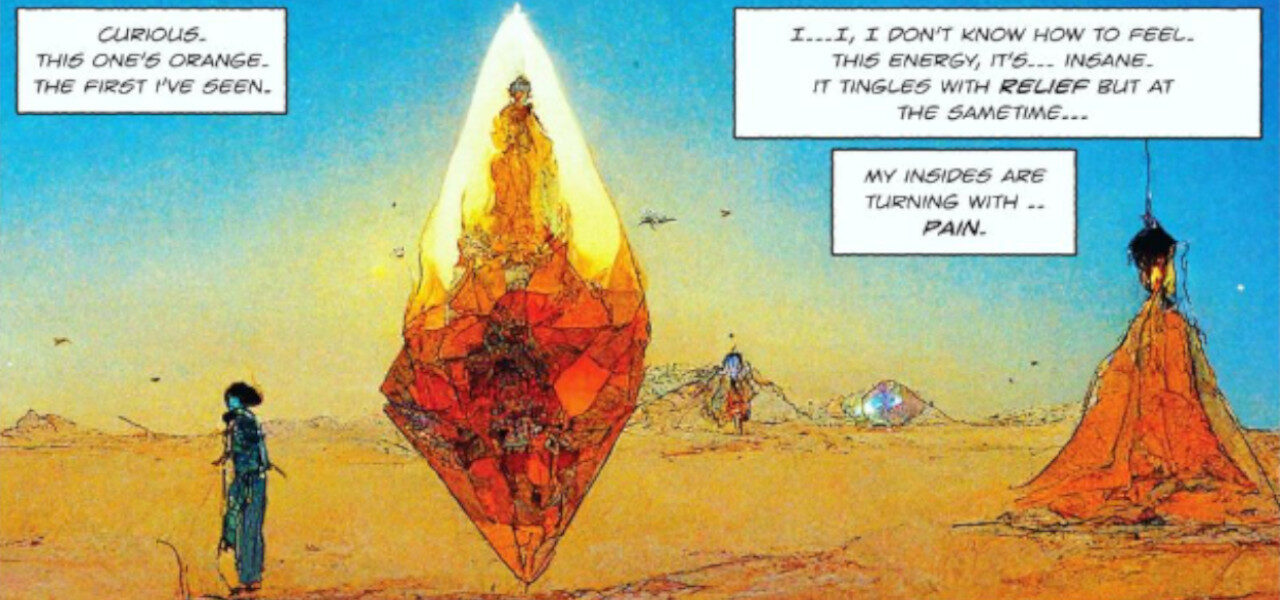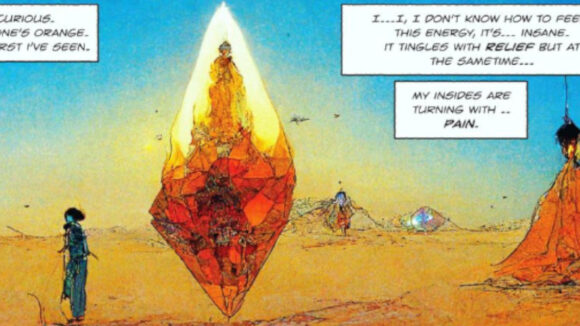

As The Debate Over AI Rages, Artists Are Already Using It To Illustrate Entire Comics
Artificial intelligence image generating programs like Dall-E and Midjourney are all the rage, but more than just a resource for generating memes, veteran artists are using the software to create narrative artwork in entirely new ways.
In June, Melbourne-based freelance art director Jordan Booker, inspired by the work of Mœbius, published The Terrible Misfortunes of an Intergalactic Traveler, a full narrative digital comic featuring illustrations created entirely with Midjourney. Booker wrote the dialogue and put in some serious time editing and playing with prompts, but the visuals in the comic were generated entirely by the software.
The strip’s synopsis reads: “Having crash landed on an alien planet. Our protagonist makes its way through a surreal landscape, whilst two powerful entities attempt to lure them.”
Booker described the process he used in an accompanying post:
Super tedious task achieving some relative consistency across the board. Nevertheless excited with what this platform can bring to creatives and directors alike. Onto my next Mid-Journey challenge.
Inspired by Booker’s efforts and the often critical musings of Irish filmmaker David OReilly (Please Say Something, The External World) on the subject of AI-generated artwork, Danish animation director and audio-visual artist Christen Bach put together Entering the Data Core, an AI-illustrated comic of his own.
He included an informative and detailed account of his process, and some more philosophical thoughts on AI-generated artwork, explaining:
As I started playing around with the A.I. tools it dawned on me how quick it would be to generate quite complex imagery and string it into a narrative – and decided to reignite my old love for the comic book format. The process comes with a cost though. You will have to view the A.I. as a collaborator. You can notch it in a direction, but you don’t have 100% control, so you need to keep a flexible mind. I generated hundreds of images for these 10 pages, and constantly had to compromise on the images and sequences I had locked in my mind while writing it. Still, I was able to churn everything out in about 3 workdays (ca. 24 hours collected) from nothing to final result.
I see it like this: These new tools has an immense power. They are super fast. They can tirelessly generate new variations on a theme. They are a collaborator that can excite and surprise you in the creative process (as well as frustrate you when you are out for something really specific). They can help loosen your mind from your normal creative patterns. BUT… it is not about the pictures being generated, it is about how we as artists or storytellers choose to use/curate/stage those pictures.
In June, oil painter and cartoonist Carson Grubaugh created a four-issue physical comic book series titled The Abolition of Man which will be available to purchase in October of this year.
“What do you get when you take a groundbreaking philosophical essay and feed it into an AI image generator, one line at a time? The world’s first (and only) entirely-computer-illustrated comic book, The Abolition of Man issue #1,” reads the comic’s promotional pitch.

It’s clear that AI software isn’t yet at the stage where a user can describe a story and get a fully-finished comic, or animation for that matter, but the sophistication of the images being produced is creating a serious discourse. In a recent Instagram post, OReilly decried Dall-E as a “scam” and argued that it “undermines the work of creators of all kids, most obviously photographers, illustrators, and concept artists who shared their work online and never asked to be included in a proprietary learning model.”
While the ethical debate rages over AI, these early creative experiments with the technology add to the conversation and show how artists are using the tools to creative ends.
